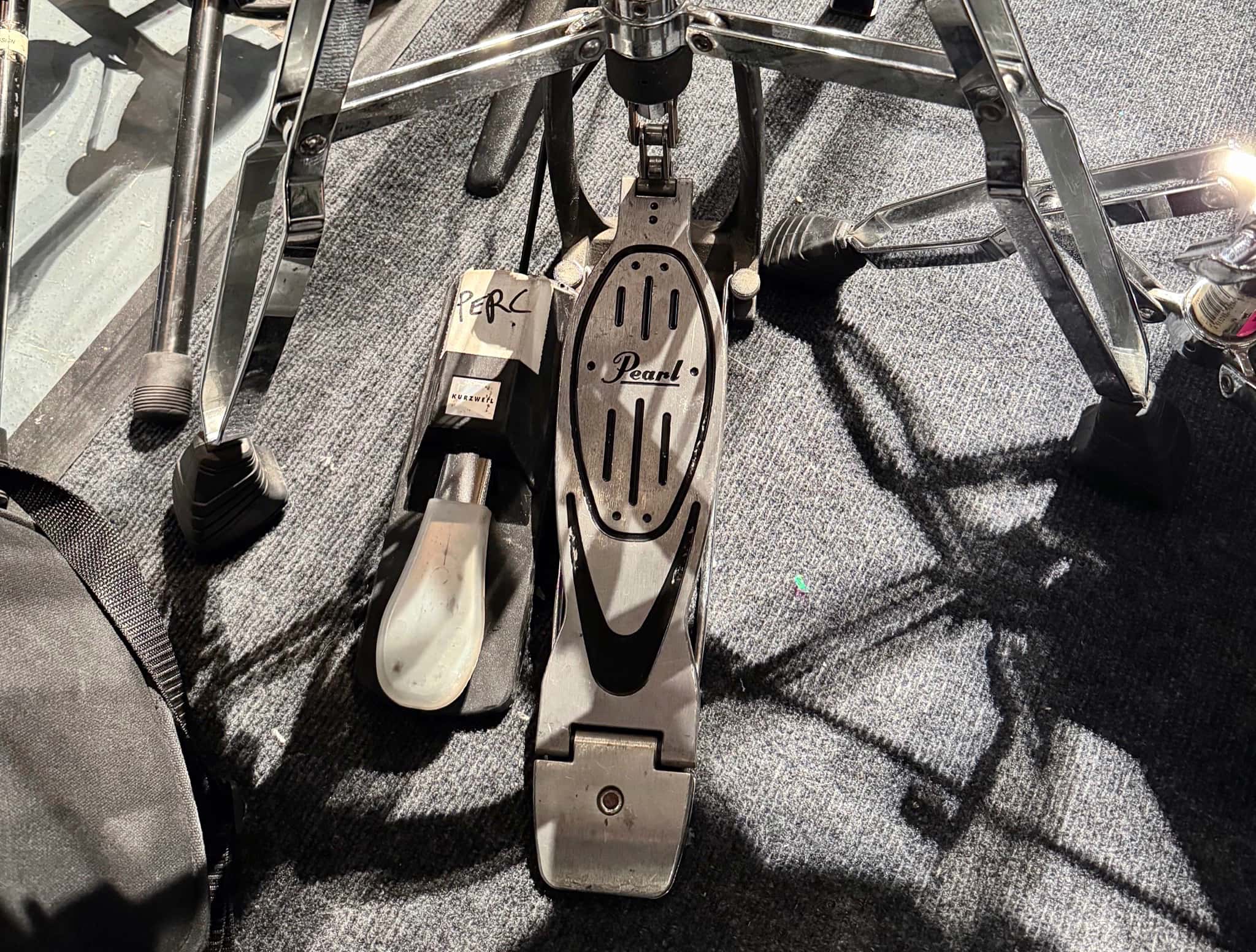
Little Women - Sal Mazzotta
Sal Mazzotta's setup for the National Tour of Little Women at the RiverPark Center in Owensboro, Kentucky.
Write-up and gear list below photos.













 Below: Roland INTEGRA-7 SuperNATURAL Sound Module
Below: Roland INTEGRA-7 SuperNATURAL Sound Module
 Below: ProX X-CS20 T-Stand, for mounting MalletKAT over Bass Drum.
Below: ProX X-CS20 T-Stand, for mounting MalletKAT over Bass Drum.







 Below: Matt Witten's setup for the 1st National Tour of Little Women.
Below: Matt Witten's setup for the 1st National Tour of Little Women.
Sal-
The Score:
I think most people who’ve seen this show would agree that the score is really inspiring. It has a good balance of ear candy and ear worms. We were given copies of the original book and didn’t really change much in terms of melody, harmony, and song form.
However, since our pit is smaller than the original run, and because my version of the setup relies heavily on electronics, both our Musical Director and Orchestrator re-orchestrated textures and re-voiced the harmony a bit throughout the show — even in my book.
There’s a good amount of marimba in the original. We left a lot of those licks in, but changed the instruments often. Some parts went to Vibes. Some went to Xylo. Some stayed the same, but some even got cut for snare drum or timpani in order to fill out the sound of the orchestra more.
Since we opted to cut the field drum, we also rewrote some of the snare drum parts to make more sense with what we have. They’re a little less busy.
Our pit: Keys, Reed 1, Reed 2, Trumpet, Violin, Cello, Bass, Percussion
The Setup:
When I got the call for this gig, I did some homework and learned that Matt Witten was the percussionist for the 1st National Tour of this show. I had already known Matt for a while, so I picked his brain about it. He sent me a picture of his setup (pictured above) and pointed out things to look out for.
Matt played everything acoustically. That wasn’t going to be possible for me due to the nature of this kind of tour. We don’t have many sit-downs in our schedule. It’s mostly one or two days in each city. I was also told that there will be days when I’ll have 30 minutes or less to set up everything, so I decided to put all of the pitched percussion on a MalletKat (even timpani) and condense everything else down into a small acoustic setup.
At first, the team wasn’t totally sold with programming timpani on the MalletKat. They had also brought a Yamaha DTX specifically for timpani, but I worked with our keyboard programmer, Jim Harp, and the sound team to try and get them to sound as real as possible.
The Roland module that we’re using has some pretty good sounds, and Jim showed me a cool trick with it where we’re essentially using extra patch changes to 'muffle' the sample as you would with real timpani. I’m using a single foot switch to change patches and muffle timpani but also have a sustain pedal, so I have some quick footwork going on in certain passages.
The Tour:
I’ve toured before as an audio engineer (non-theatre), and have traveled a good amount for playing gigs, but this is my first time actually touring as a musician.
The days can be very long, and there are definitely some challenges with stamina. More often than not, we’re arriving at a venue after a long bus ride, setting up the show, playing a show or two, and breaking down the show all in the same day before getting to a hotel at midnight just to rinse and repeat the next day in another city.
Surprisingly, that’s not really bothering me much so far. Everyday is a new adventure in a new place, and I’m actually enjoying it more than I thought I would. We’re really fortunate to have a great group of people. I think that’s making a big difference. All of us (cast, crew, and orchestra) get along really well, and we have each others’ backs when the days are tough.
For me, the hardest part of this is the same thing that’s hard back at home — trying to nail the show every night, cold. It doesn’t help that my setup, and even the configuration of our pit, has been different at every venue after leaving from our opening week, in Owensboro, Kentucky.
Since then, I’ve been close to the rest of the pit. I’ve been 30 feet away from them. There are days coming up when I’ll be remote. There are days coming up when the whole pit will be remote. Most days, my setup is not exactly as I envisioned it — video monitor in an inconvenient place, equipment at inconvenient heights, the entire setup being really compressed, etc.
What’s coming in super clutch is everything that I’m learning from my friend, now drum teacher, Dan Berkery.
The Path:
Dan is an incredible player, and as a teacher he’s really diagnostic and precise. He’s like a surgeon. I asked him about these kinds of situations specifically, and he broke down his whole philosophy for me.
He’s really big on ergonomics and effortlessness. His approach to the drum set heavily reminds me of Buster Bailey’s snare drum technique, which I originally learned from my mentor, Dean Witten.
You have to be so “supremely relaxed,” as Buster put it, using only the amount of tension necessary to play. It’s extremely tedious to learn. I never truly mastered it during my school days, so I’m really glad to be revisiting the concept with Dan and expanding it by applying it to the whole kit. It influences everything from my strokes to my posture on the throne and produces a really smooth legato sound.
Now, when moments arise in which my setup has been crammed between a doorway, above a flight of stairs, for example, I fall back on Dan’s ideas and try to make sure that the base position of my body is supported in all the ways that I need for me to be flexible. That way, I can adapt to any non-ideal or unexpected momentary situations that come up during a show.
Just doing this alone has made a huge difference for me. I’m not a drum set player first, so sometimes I still get stuck in my own head about these kinds of things. Having Dan illuminate the path is really helping me “get out of my own way,” as he puts it, and that makes gigs like this much more manageable.
For anyone else that’s interested in lessons with Dan, you can get in contact with him through his website, https://www.danberkerydrums.com but also make sure to go check out Lempicka on Broadway [Dan is playing drums] when it opens this March. Dan just happens to have the best seat in the house!
Drums:
- Pearl 22” Kick Drum in Vision Gold Sparkle
- Rogers 16” Floor Tom
Snare:
- Pearl 14"x5" Custom Alloy SesiTone Elite Aluminium Snare
Percussion:
- Grover Pro Wood Block
- Remo Fiberskyn Tambourine
- Meinl Sleigh Bells
- Bell Tree
- TreeWorks Mark Tree with dampener
- Miller Machine with Alan Abel 04” Triangle
- Woodstock Chimes
- American Slide Whistle
Cymbals:
- Sabian 16” HHX Evolution Crash
- Bosphorus 14” Traditional Hi Hats
Electronics:
- MalletKAT Pro mounted on ProX X-CS20 T-Stand
- Roland INTEGRA-7 SuperNATURAL Sound Module
- Shure SE215 In-Ear Monitors
- Apple iPad Pro 2018 11” with forScore
Sticks & Mallets:
- Vic Firth 5A Dual Tone Swizzle
- Malletech Dave Samuels DS18 Hard Rattan Vibraphone Mallets
Little Women - Tour - Sal Mazzotta
February 3, 2024 thru Present









